
Mariano Bertuchi and the sister cities, Granada and Tetouan
The Granadan artist was 44 years old in 1920, when he moved to Tetouan, together with his wife. This city had a special meaning to the artist, for it was founded by another Granadan, al-Mandari, who escaped in the 15th century from the village of Píñar, near Granada, after the advance of the armies of the Catholic Monarchs. Al-Mandari repopulated the city of Tetouan with the people from Al-Andalus who, as he did himself, suffered exile.
This was perhaps the reason why Bertuchi always believed that Tetouan might become the repository of traditional arts to further crafts of Al-Andalus, of which he was a great admirer.
Mariano Bertuchi was considered the greatest Spanish painter of Morocco. The artist found the ideal setting lit by the brotherly reflections of Andalusia in the African country, mainly those of his hometown, Granada.
He travelled to this country for the first time just a decade after his French colleagues. Matisse, Delacroix and the Catalonian Fortuny left a trail where the magic of a fledging artistic trend, Orientalism, flourished in the heat of the Romantic movement.
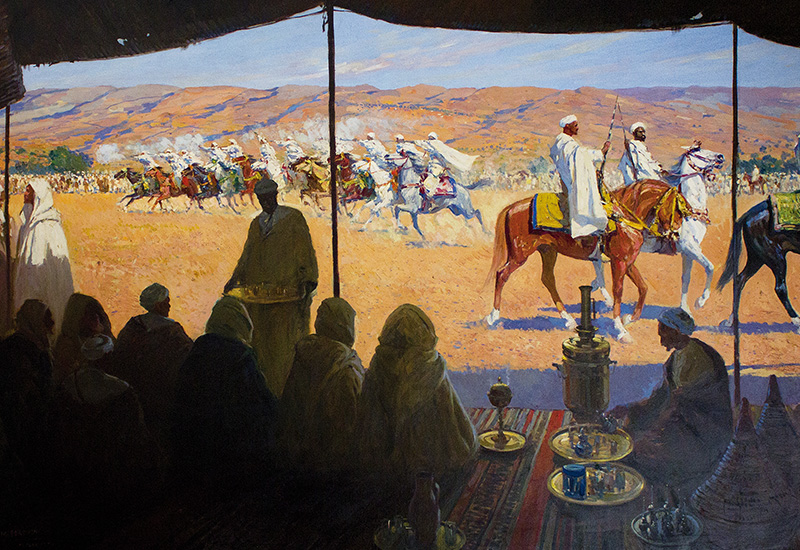
He was barely fifteen years old when he first visited Morocco. He visited Tangiers, invited by the official interpreter of General O’Donnell, who gave him this trip as a gift, knowing the devotion that the young artist felt for the neighbouring country. And he was even further captivated by the beauty of the country as a whole −its crafts, its colours, its landscapes, its people. All that sparked a great commotion in his artistic sensibility. The impact that the country caused the young artist was such that the following year he presented in Granada a successful exhibition of the works he painted in Morocco: “Fruit Market”, and “The souk of Tangier”, where he kept travelling to frequently.
Fantasia in Morocco. Mariano Bertuchi.
©Mariano Bertuchi’s heirs, 2014
He was a precocious artist; at nine years old, he was enrolled in the Málaga School of Fine Arts, in the 1893-94 academic year, and in Granada the following year. At the age of eleven he had already taken part in an exhibit, and when he was twelve he won a painting competition in his home town. He started to bear the fruits of the first notions of painting that he received from the famed artist José Larrocha. At the age of fourteen he started to paint Arab motifs, a theme that marked his career for life.
After this first visit to Morocco, he returned the following year to make a painting on the theme of Arab customs, commissioned by a resident English diplomat. In those years, the artist started to frequent the Círculo de Bellas Artes of Madrid, and to take part in several calls of its Biennale. He also lived for some years in Málaga, where he got on with his art studies. He always said that the light of Málaga and Granada found their reflections in the opposite shore of the Mediterranean Sea.
In 1928, he was appointed Chief Inspector of Fine Arts Services and Indigenous Arts and Crafts of the Spanish Protectorate of Morocco.
His devotion was recognized by the award he received in 1935, the Order of Alphonso X the Wise, for the safeguarding and preservation of Moroccan crafts, and for making Tetouan the great centre of the arts in the north of Africa. The activity he carried out as inspector in the area of Fine Arts allowed him the essential proximity to the cultural life of the region and its ethnographic aspects. His involvement in the task he was assigned was absolute; he directed his efforts toward the same direction in which he decided to act. The passion for Moroccan art he had had since he was a child flourished in a time when it was possible to reorient it in a specific direction, consolidate it and boost its aesthetic values.
The initiative of Mariano Bertuchi counted on the support of the almotacén (the public employee in charge of weights and measures) of Tetouan, Abdeslam Bennuna. Together, they set up one of the most brilliant projects to revive the crafts of Al-Andalus.
His wishes started to come true when he was appointed in 1903 director of the Schools of Art in Tetouan and Tagsut, as well as the Chaouen Carpets School. This fact, which meant the seed that was to bear its fruits years later, was favoured by the priceless collaboration and involvement in this proposal of the almotacén of Tetouan Haikh Abdeslam Bennuna.
He was actually in charge of monitoring the craft guilds in this city, as well as being the promoter of the Lyceum of Tetouan. His suggestion in its first assembly was the creation in this city of a school of arts and crafts. The proposal was immediately accepted by the Moroccan government, which assigned the corresponding budget to be allocated, and the school was managed by Bennuna and Bertuchi. On the 30th of August 1919, the expectations that they both had on this brilliant initiative were met. The institution was inaugurated under the name of Tetouan Arts and Crafts School.
Bab Okla or Gate of the Queen, near the Tetouan Arts and Crafts School.
Gardens of The Arts and Crafts School
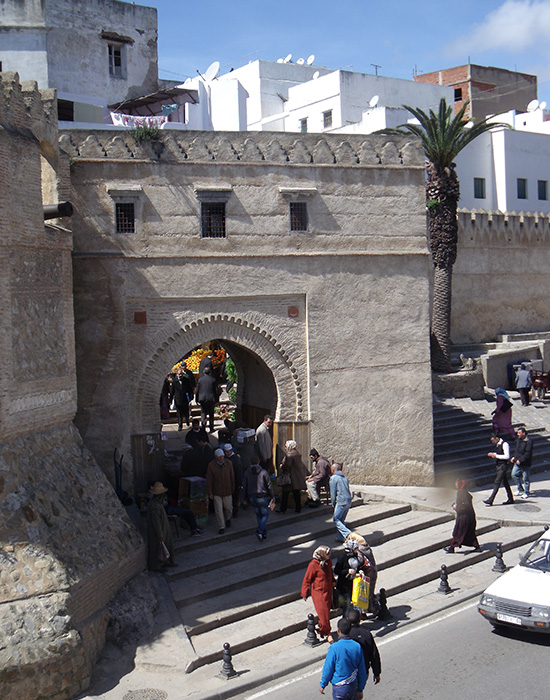
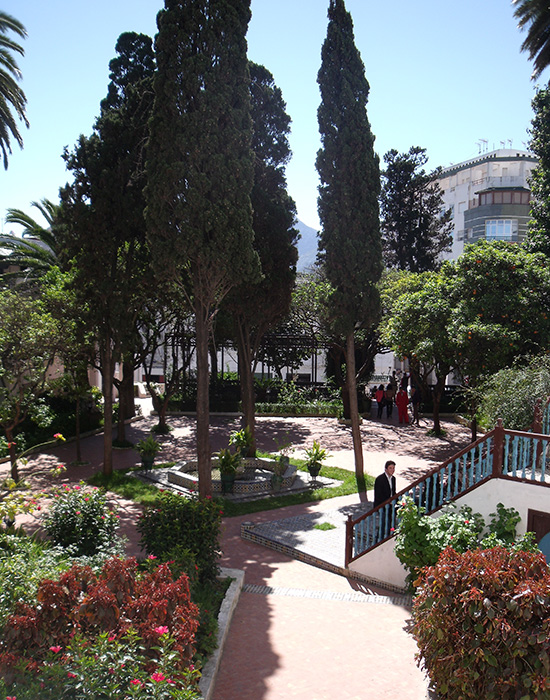
The School changed its name and location three times over the last century. In the 1920’s a building was specially erected to house what was named The School of Arts and Indigenous Crafts, which later on, in 1927, changed its name to School of Moroccan Crafts. The institution facilitated the learning of traditional crafts like woodwork and carving, ceramics, fabrics for rugs and other textiles, leather and fabric embroidery, silver inlay, stamping in different materials, decorative painting, and artistic ironwork. Young apprentices earned a salary during their training period, and they were given by the Fine Arts Inspector a title that certified the mastery of their trade. This initiative was largely accepted by young people who could soon start in the profession either as employees or by setting themselves up independently.
The promotion of the School was a major factor in making Moroccan crafts known, and it was undertaken by means of the organization of exhibitions and the participation in fairs at an international level. Many were the awards and distinctions that credited the task of the school, but above all it was the great dissemination that that the institution originated, as the guardian of the authentic crafters’ skills, that was to be preserved and transmitted, and that made possible private workshops that began to proliferate in Tetouan and in other Moroccan cities like Larache or Chaouen, among others. In the same way, other Arts and Crafts schools were founded in Morocco that had as master craftsmen those who were formerly outstanding pupils and zealous guardians of the traditional techniques of Moroccan arts. Mariano Bertuchi managed to recover the good know-how and traditional knowledge of the Moroccan artisan, the heir of the purist style and expertise of their ancestors from Al-Andalus. Hence, he reclaimed the best conditions to guarantee the values of the old way of doing these things. In this sense, he vetoed the use of industrial devices that came only to hinder, and sometimes to destroy, what artisans had forged over the centuries with tremendous hard work. He suppressed the use of additives and chemical colourings imported from Europe, like aniline, in favour of the natural and vegetable dyes traditionally used.
There is no better explanation for the broad significance of the work done by Mariano Bertuchi than that offered by the illustrious Spanish Arabist Rodolfo Gil Benumeya:
“[…] the School recovers an ancient tradition of incalculable value that today gives to Morocco a superior significance in the world of Arab culture. It strengthens the sentimental ties between that country and the Spanish South, the origin of the initial impulse that this art has rekindled. He gives to the modern way of life, so restless and hectic, the appeasing performance of an art made from serenity, disdainful of hurry. Muslim producers create at a relaxed pace, because they not only use work and strength in their labour, but also dedication and spiritual zeal. There is a union between the creator and the work created born out of the pursuit of perfection, a perfection that is a matter of pride for the Spanish traveller when he does not forget that the Moroccan artisans are the descendants of a lineage from Granada, and that the detailed beauty of their techniques was born under the russet shade of the Alhambra’s towers. Perhaps that is why Bertuchi has known how to restore the hidden meaning to these artisans, because they are also Granadans. Hence, his work and personal links, departing from the school, space and time in the shores of the Strait shores, unite Andalusia and Morocco”.
Painted wood carving. Tetouan Arts and Crafts School.
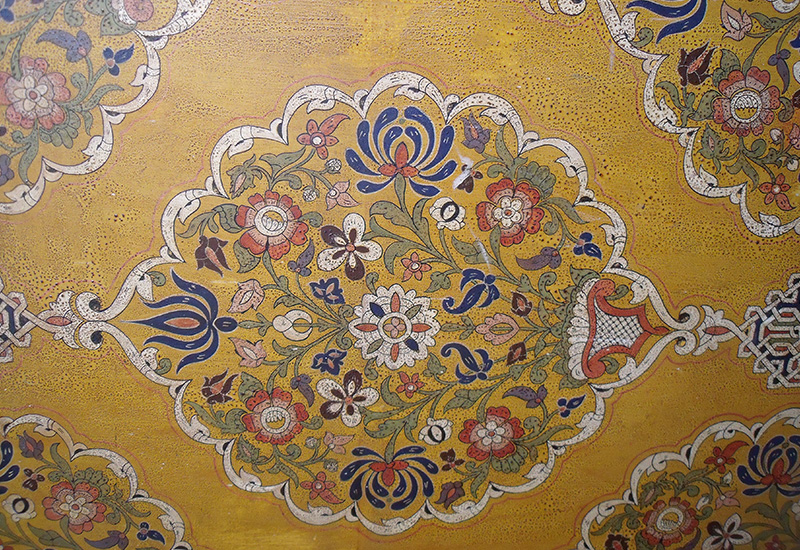
Despite Bertuchi’s devotion to the Hispano-Moroccan traditional industries, the artist did not set aside his aspect as a painter. Departing from the experience he received from the students who were learning traditional arts, he felt immersed in the keen observation of the Moroccan kids’ skill for plastic arts, of whom he wrote in the newspaper La Gaceta de Africa in January 1935:
“The artistic spirit of this race effectively cooperates with this aim, which offers us the hope of having the Moroccan standing out in painting relatively soon. There are already many Muslim young people who are earnestly and keenly devoted to drawing. The Fine Arts Inspection encourages their interests by allowing them to express themselves freely, without submitting the works to rules or standards, in order to get a spontaneous art […]. We already see them frequently working on coloured drawings trying to make faithful copies of the natural, works that they decorate with the stylizations of their innate fantasy…”
He then decided to expand the teaching of artistic traditional works and include painting, a previous step to foster the Tetouan High School of Fine Arts that was temporarily inaugurated in 1945, and which started to operate under the direction of the master the following year. Long was the list of teachers who guided the first steps of quite a number of Moroccan and Spanish artists who nurtured with their contribution not only the landscape of plastic arts, but also forged a wealth of teachers in higher schools, first in Spain, and next in Morocco.
In the present times, and after having changed name and location on several occasions, the school is located at Bab Okla, named today the Queen Gate, which in ancient times was known as Watermills Gate. The gate was in those times outside the medina, where farmers, merchants and traders from the neighbouring villages gathered. There, they left their animals and unloaded their cargoes to be sold within the medina afterwards. The multicoloured scene, full of life and movement that this setting offered outside the city, was one of the of Bertuchi’s favourites. It was a recurring theme that he never tired of painting. Hence, the place chosen to locate the school founded by the artist has a double importance, as dual legacies, the spiritual and the physical, that the Granadan left visible in this city.
Bertuchi also took part in certain way in the architectural design of the School. The building was to be to the image and likeness of the noble palaces and farmsteads of Al-Andalus, where its most significant components, both so Andalusian and so much from Al-Andalus at the same time, would not be missed: a yard with its garden, its fountains and pools and its whitewashed outer walls, decorated with wonderful green tiles from Fes. In the yard were classic trees from the gardens of Al-Andalus as well as from the Granadan carmen (the typical house from Granada’s Albaicín quarter). Cypresses, lemon trees, palms and expansive lawns full of flowers and aromatic plants ̶ the essential jasmine ̶ the perfume the environment. Ponds or pools added to the site the long sought-after sensation of every Al-Andalus construction, either aulic or popular: the presence of water that covers with its murmur, without disrupting, the calm of gardens and rooms of the interior, which are cooled by its mere sound. The two pools are decorated with tiles, and different species of birds gather there. The beauty of the building and its riad made an emblematic space of the Al-Andalus art of living. Not in vain, the UNESCO declared it a World Heritage Site in 1997. With an extension of the 3,000 square meters that surrounds the garden, host in the interior a shaped like a U pavilion with a permanent exhibition hall, a library, an offices area, a gallery for temporary exhibits and the workshops that are placed in the lateral sides of the building.
In these workshops are made crafts such as painted wood ̶ carved or inlaid ̶ pottery, silversmithing, forging, looms, plasterworks and copper to produce items like lamps, leather accessories, embroidery…
The pavilion also has a theatre hall, the heritage library and a smart-space equipped with the latest technology. Inside the building, creative samples of colourful painted furniture as well as copper lamps and chandeliers are shown, both as exhibits and decoration. . Pictures from other times offer a look at the landscapes of the past, and for these it is necessary to pay attention not only to their artistic value, but also to see the physical evolution of this sister and neighbouring city.
Other architectural elements, such as columns -̶ decorated with beautiful kufic calligraphy ̶ or painted, carved cedar ceilings, immediately evoke the Alhambra in the times when the Nasrids were its dwellers.
Tetouan Arts and Crafts School embroidery workshop
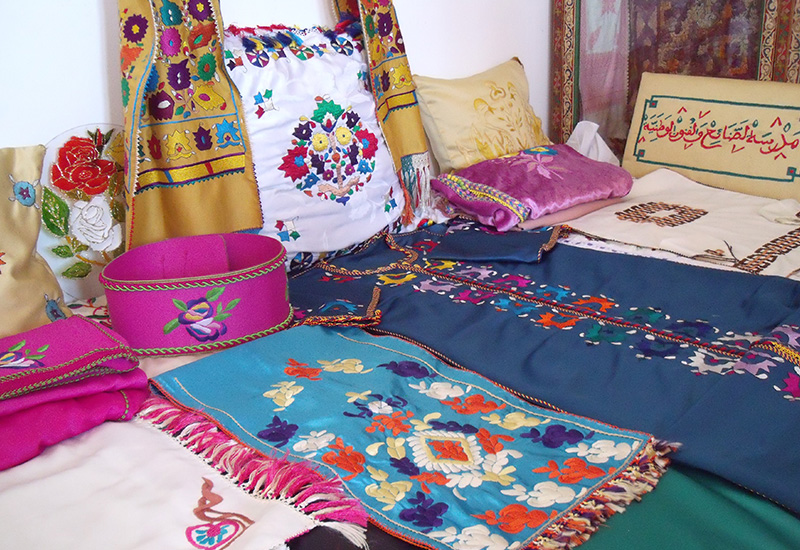
This centre constitutes the cultural reference par excellence of Tetouan. Its cultural programming includes concerts, conferences, lectures, art exhibits, photography and numismatics among others. In the same way, meetings of different associations and foreign embassies are organized. In its exhibition hall, the best artisanal works are on display permanently, an important stimulus so that the students can see the accomplishments of their determination in the traditional tasks of arts and crafts, where the diversity and the richness of local crafts reign.
To be able to transmit the rich artistic legacy, the workshops were designed in the traditional style, using the guidelines of the old workrooms of the medina. The Arts and Crafts School has already trained several generations of students. Historically, and since its very beginning, the school was the connection node for a tight Hispano-Moroccan collaboration that was to allow the preservation of a rich cultural and artistic patrimony shared by the two countries, and hence guaranteeing its transmission to future generations. In this way, the task of specialization in the school was soon reflected in important projects related to Andalusia, and its participation in the process of restoration and decoration of important buildings like the Morocco Pavilion in the First Universal Exhibition of Seville (1929), and the Cooperation Program among Spain, Portugal and Morocco entitled “Gate of the Mediterranean”, which consisted in the restoration of historic sites of Muslim influence in the south of the Iberian Peninsula and in the north of Morocco.
There is no doubt that the Arts and Crafts School of Tetouan succeeded in not only perpetuating an endangered artistic legacy, but also in generating an important economic engine that has brought about development.
Promotion and distribution were carried out through diverse marketing efforts, and the participation in fairs and international forums. The craft items are very much appreciated and unique, and they mostly find among their public fans of the Moroccan crafts. It represents a creative universe for the collectors who know that the finding of an interesting antique might await them, or they might be surprised by a young creator’s new vision, one who faces the challenge of tradition versus innovation. However, there is no doubt that the value is always for the increase of “handmade” for all items, as the spirit of these artisans is a treasure of fundamental values: the creative spirit, knowledge, an absolute dedication and the profound love for their work.
By Ana M. Carreño Leyva. Fundación Pública Andaluza El legado andalusí

